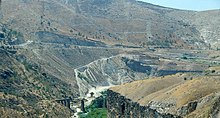Yarmuk (river)
| Yarmuk | |
|---|---|
Arabic) | |
| Location | |
| Country | Syria, Jordan, Israel |
| Region | Middle East, Eastern Mediterranean littoral |
| Physical characteristics | |
| Source | |
| • location | Hauran |
| Mouth | Jordan River |
• location | Naharayim/Baqura Area Israel/Jordan |
• coordinates | 32°38′39″N 35°34′22″E / 32.64417°N 35.57278°E |
| Length | Approx. 70 km (43 mi) |
| Basin size | Approx. 7,000 km2 (2,700 sq mi) |
| Discharge | |
| • average | 14.5 m3/s (510 cu ft/s) |
| Basin features | |
| Tributaries | |
| • left | Ruqqad, 'Allan |
| • right | Ehreir, Zeizun |
The Yarmuk River (
History
Yarmuk forms a natural border between the plains to the north - Hauran, Bashan and Golan - and the Gilead mountains to the south. Thus it has often served as boundary line between political entities.[6]

Neolithic
The
Bronze Age

Abila (Tel Abil) is attested in the 14th-century BC
Iron Age
The
Hellenistic period
In Hellenistic times, the territory of
Byzantine period
The Battle of the Yarmuk, where Muslim forces defeated those of the Byzantine Empire and gained control of Syria, took place north of the river in CE 636.
1905–1948
A fork of the
After 1948

Today, the lower part of the river, close to the
The Al-Wehda Dam was constructed on the border between Jordan and Syria in the 2000s. There are political agreements between Jordan and Syria (1953 and 1987) and between Jordan and Israel (1994), about the management and allocation of the shared waters of the Yarmouk.[9]
References
- ^ Meyers, E. M.; Brown, J. P. (October 27, 2017). "Hieromyces (river): a Pleiades place resource". Pleiades: a gazetteer of past places.
- ^ "TM Places". www.trismegistos.org.
- ISBN 9781472558299. Retrieved 2021-04-07.
- ^ It is one of three main tributaries which enter the Jordan between the Sea of Galilee and the Dead Sea; to the south there are the Zarqa (Jabbok) and the Mujib (Arnon) rivers.
- ^ "YARMUK - JewishEncyclopedia.com". jewishencyclopedia.com.
- ^ a b c d e Ma'oz, p. 420
- ^ ISBN 978-0195112153.
- ^ Yarmuk River railway bridges, 1933 aerial photographs. Aerial Photographic Archive for Archaeology in the Middle East / National Archives, London.
- ^ a b Hussein, Hussam, and Mattia Grandi. "Dynamic political contexts and power asymmetries: the cases of the Blue Nile and the Yarmouk Rivers." International Environmental Agreements: Politics, Law and Economics (2017): 1-20.
External links
 This article incorporates text from a publication now in the public domain: Singer, Isidore; et al., eds. (1901–1906). "Yarmuk (modern Shari'at al-Manaḍirah)". The Jewish Encyclopedia. New York: Funk & Wagnalls.
This article incorporates text from a publication now in the public domain: Singer, Isidore; et al., eds. (1901–1906). "Yarmuk (modern Shari'at al-Manaḍirah)". The Jewish Encyclopedia. New York: Funk & Wagnalls.- Yarmouk Hydro-Political Story Map by the UEA Water Security Research Centre
- Photos of Yarmouk river at the American Center of Research
